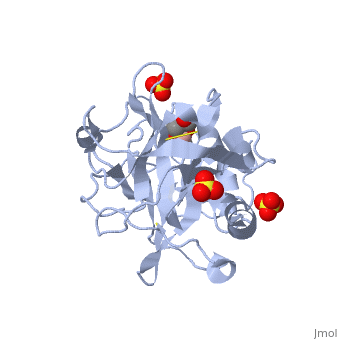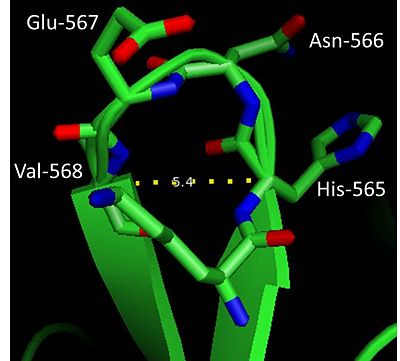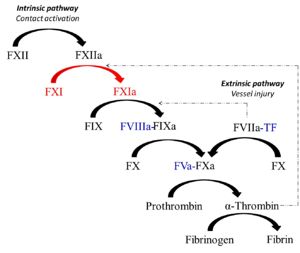
Schematic representation of the coagulation response
Coagulation Factor XIa
Introduction
Factor XIa is unique protease derived from the activation of the coagulation zymogen, factor XI. Factor XIa partcipates in the procoagulant response via contact activation pathway. Synthesized by the liver similar to most vitamin K-dependent coagulation proteins, the zymogen, factor XI circulates in plasma as a 160 kDa disulfide-linked homodimer in complex with high molecular weight kininogen (HK)[1]. Studies show that factor XI is a substrate for various plasma proteins such as factor XIIa, thrombin, meizothrombin and factor XIa (via autoactivation). Proteolysis of the bond generates the active enzyme factor XIa which in turn cleaves its substrate factor IX to produce the serine protease factor IXa.
Protein Structure
Factor XIa is a linked-dimer of similar amino acid composition of approximately 625 residues. The first 18 amino acid residues constitute the signal peptide whereas residues 19-387 and 388-625 represents the heavy- and light- chains of the factor XIa molecule respectively. The protein forms five main distinct domains. Beginning from the N-terminus,each dimeric subunit contains 4 apple domains (, , and ) which are characterized by approximately 90 or 91 amino acid residues. Protein-protein interactions are thought to be the primary role of the apple domains. The is reported to mediate binding to platelet glycoprotein Ib (GPIb)[2] as well as interactions with exosite I of thrombin, and kringle 2 domain of prothrombin. The is the main site of factor XI protein-protein interaction when in complex with high molecular weight kininogen[3]. The C-terminus (heavy chain) of factor XIa contain a trypsin-like catalytic domain [4]. Together with Prekallikrein (PK) a monomeric homolog of factor XIa, they belong to the PAN (plasminogen, apple, nematode) module family which all have a conserved N-terminal apple domain found in hepatocyte growth factor and plasminogen [5].
Secondary structure
About 36 β-strands have been observed in the crystal structure of factor XI with twice as much found in the heavy chain (25 β-strands) compared to the light chain (11 β-strands). The topology of the apple domain reveals 7 antiparallel β-sheets and an α-helix which fold into a compact structure as oppose to an extended structure found in the vitamin K-dependent serine proteases. This core PAN topology is also found in leech antiplatelet protein and hepatocyte growth factor[6]. A single disulfide linkage connects the C- and N-terminals of the dimer whereas two disulfide bond join the helix to the 4β- and 5β-sheets. The apple domains of factor XIa are tightly linked to each other forming a disk-like structure close to the base of the C-terminal catalytic domain. This observation is consistent with the high surface area measurements for the side interfaces between apple domains and (441ÅxÅ) and between and (444ÅxÅ) in contrast to smaller end interfaces between and (380ÅxÅ) and between and (284ÅxÅ).
β-barrel
The FXIa serine protease-like domain found in the light chain region of the enzyme contains 2 connected by a central loop. Factor XI could be classified as an all β protein since β-sheets predominate in its structure with a few helices. It is therefore not suprising that the observed were entirely connected by loops. Although the β-strands which form the β-barrel in factor XIa form an up and down pattern charateristic of a Greek key and Up and Down β-barrels, the interconnect loops are very different. Most serine preteases however contain 2 Greek key β-barrels as a secondary structural element.
β-turn
The globular and compact nature of factor XIa as opposed to an elongated form (prevalent in vitamin K-dependent serine proteases) could in part be attributed to the abundance of β-turns in the protein. β-turns are characterized by a hydrogen bond involving carbonyl oxygen (C=O) of residue (i) and amide hydrogen (NH) of residue (i+3). The heavy chain has ~4 β-turns and one such β-turn (residues 566-568) is found in the light chain of factor XIa (see figure on the right). This β-turn based on distance between Cαi-Cαi+3 (5.4Å) and the measured dihedral angles: φ(i+1)=50.5°, ψ(i+1)=47.2° and φ(i+2)=90° and ψ(i+2)=15.8°could be classified as Type I′ according to Hutchinson and Thornton (1994)[7].
α-Helix
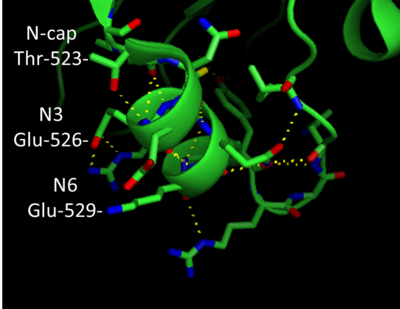
N-terminal capping motif in factor XIa
In addition to β-sheets, factor XIa folds into a number of α-helices. The heavy chain region has ~8 helix repeats while about 5 helix repeats are present in the light chain region of the protein. Helices that are capped at either the N or C-terminals forming a capping motif. Helix Capping Motif display a unique hydrogen bonding pattern in addition to hydrophobic interactions. Factor XIa has an N-terminal capping motif in the light chain: residues 523-531 form an α-helix (see the figure on the right). Thr-532 is the Ncap and Glu-526 is found at the N3 position of the helix. The N-terminal capping motif shown in the figure (right hand side of page) appears to belong to the capping box classification. Thus the side chain of Thr-523 forms a H-bond with the backbone of the N3 however, H-bonding between the side chain of N3 and backbone of Ncap is absent. Next to the C-terminal Cys356 of the domain,factor XI assumes an interesting helical element the . Originally classified as a type III turn, the is tight and contains 3 residues (357-360) per turn.
Factor FXIa dimer
The β-sheets form a tight packing against each other with two A4 domains forming a large interface between the dimer subunits. Found in the central position is the main interchain disulfide bond contributed by Cys-321 located on the finger-like loop of the A4 domain. The apple domains form a V-shape in which two A2 domains are distanced ~50Å apart whiles the A1 and A3 domains from adjacent monomers are in close proximity of 5Å apart [8]. The interface made up of Leu-284, Ile-290 and Tyr-329 and the between Lys-331 of one monomer and Glu-287 of the other monomer are absolutely required for dimer formation[9]. Most of the complex protein-protein interactions involving factor XIa are mediated by the apple domains of the dimeric subunits.
Posttranslational Modification
Unlike most serine proteases which contain a γ-carboxyglutamic acid (Gla) domain, which facilitates the binding of vitamin-K dependent coagulation proteases to phospholipid vesicles, plasma factor XIa lacks the Gla domain. Meanwhile the protease undergoes considerable posttranslational retailing following it synthesis. Approximately : 15 of which are confirmed and 4 potential disulfide linkages are reported to be present in factor XIa molecule. The homodimers are linked by a single disulfide bond at Cys-321 connecting the A4 domains of each subunit [10]. Ser-17 and Thr-22 are phosphorylated [11] whereas 5 N-linked glycosylations (GlcNAc) sites were also reported following glycoproteome analysis [12].
Serine Protease Enzyme Mechanism
Formation of Factor XIa
Factor XI is partially proteolyzed in vitro by thrombin and factor XIIa generating the active serine-protease, factor XIa. Similar to other chymotrypsin-like proteases, its topology consist of two β-barrels linked through a central loop. Next to the C-terminal Cys-356 of the factor XI heavy chain, the polypeptide forms a 3-10 helix conformation and again turn sharply 90 degrees at Cys-362 forming a disulfide bond with Cys-482 within the active site region.
Thrombin-catalyzed proteolysis of factor XI involves crucial interations with Glu-66, Lys-83 and Gln-84 of the A1 domain (this ensures maximum proximity to the of factor XI) of the factor XI molecule through its exosites I and II regions [13]. Thus binding of thrombin to one subunit of the zymogen dimer promotes cleavage of the bond between contained in the of factor XI. The (residues 370-376) consequently undergoes the greatest conformational change as Ile-370 is displaced ~20Å from its position in factor XI and inserts into the activation pocket of factor XIa producing the oxyanion hole in the active site of the protease [14].
Substrate Recognition and Cleavage
The primary substrate of factor XIa is another zymogen, factor IX which is cleavage sequentially at the peptides bonds between Arg145-Ala146 and Arg180-Val181 of factor IX to release an activation peptide [15]. Recognition of the substrate (factor IX) involves residues different from the residues. In the inactive zymogen (factor XI), the highly conserved is buried in the interface between the apple domains and the catalytic domain where it interacts with : Ser-268 from the A3 domain and Asp-488 and Asn-566 in the catalytic domain. Thus following activation, is believed to constitute a switch which undegoes a conformational change breaking its interaction with Ser-268, Asp-488 and Asn 566 facilitating the protease interaction with factor IX [16].
Active Site Residues
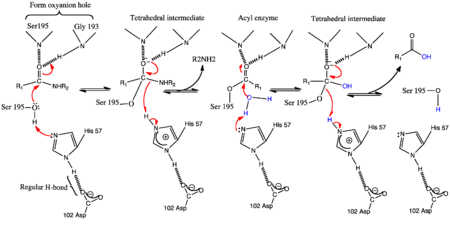
The Conventional General base Mechanism of serine proteases
Similar to other members of the serine protease family, factor XIa bears the two β-barrels topology unique to chymotrypsin-like proteases which are linked through a central loop. Thus cleavage at of the zymogen generates a functional enzyme. the catalytic triad residues Ser-557, Asp-462 and His-413 constitute the of factor XIa.
The Conventional General Base Mechanism of Serine Proteases
The catalytic triad residues assume their correct orientation following the proteolysis of the activation peptide to form a competent enzyme. The carbonyl group of the scissile bond to be broken is positioned closely to the β-OH group of Ser195. His57 is also located in close proximity to abstract a proton from β-OH group of Ser195. H-bonding interaction between the carboxyl group of Asp102 and Nδ1-H of His57 allows His57 to act as a general base.
Thus, the Nε2 of His57 acts a the general base to enhance the nucleophilicity of the catalytic Ser195-OH by abstracting its proton. The acylation phase occurs with the attack of the carbonyl of the scissile bond generation the transition state intermediate. Also known as the tetrahedral intermediate, the negative oxygen ion in this structure is thought to be stabilized by the oxyanion hole formed by the amide backbone hydrogens of Ser195 and Gly193. The collapse of this intermediate involves the abstraction of the Nε2-H of His57 (general acid) by the leaving group P1' nitrogen of the substrate forming the first product and an acylenzyme intermediate[17].
During the deacylation phase of the mechanism,water molecule is activated to act as the nucleophile by the abstration of a proton by the Nε2 of His57. The resulting nucleophilic OH anion attacks the carbonyl of the acylenzyme to generate another tetrahedral intermediate whose subsequent collapse releases the carboxylic half of the second product[18].
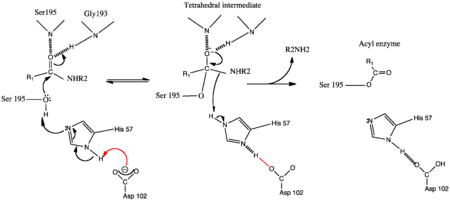
The Charge Relay Mechanism of serine proteases
The Charge Relay Mechanism of serine proteases
Blow and colleagues crystallized chymotrypsin in the presence of K2PtCL4 at a resolution of 5.8 Å and proposed a hydrogen bonding network between Asp102, His57 and Ser195[19]. Popularly known as the charge relay mechanism, Blow and colleagues proposed that, a two concerted proton transfers must occur in the transition state for the tetrahedral intermediate to be formed. Thus inaddition to His57, Asp102 acts a base to abstract a proton from the Nδ1-H of His57. On the contrary, later studies refuted the role of Asp102 as a base. Neutron diffraction studies[20] and NMR data[21]revealed His57 as the only base and the presence of positive charge on the imidazole ring respectively.
The LBHB-mediated General Base Mechanism of serine proteases
NMR studies looking at the chemical shifts for the imadazonium ion (12ppm) in the tetrahedral intermediate and imidazole ring (11pm) in both the conventioanl general base and charge relay mechanisms respectively, were entirely different from the low field proton of His57 which was greater than 18ppm. This value is characteristic of a low barrier hydrogen bond (LBHB).
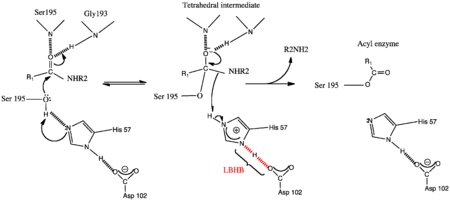
The LBHB-mediated General base Mechanism of serine proteases
LBHB is a strong hydrogen bond formed between two heteroatoms in which the distance of the hydrogen from either the donor or acceptor is equivalent (i.e. <2,55Å) and the ΔpKa between heteroatoms sharing the H-bond is ~0[22].
In a model not widely accepted by some enzymologists, Pery and colleagues proposed that in the LBHB-facilitated general base mechanism, Nε2 of His57 abstracts a proton from the β-OH of Ser195 in the transition state for its subsequent addition to the substrate-carbonyl group. Thus, the imadazole-carboxylic acid interaction is stablilzed during the formation of the tetrahedral intermediate by the formed by the interaction between Nδ1 of His57 and β-COOH of Asp102[23]. Proponents of this theory suggest that, the catalytic properties of α-chymotrypsin-mediated by LBHB would be lost when His57 is modified. As expected, N-methylation of His57 led to 0.2 million-fold reduction in acylation of α-chymotrypsin[24]. Single substitution mutation (Asp102->Asn) in trypsin resulted in a 1/10th decrease in catalytic activity in the mutant[25].
The His Flip Mechanism of Serine Proteases

The His Flip mechanism of Serine proteases Studies on the central role of His57 and its orientation as regards functioning as the general base and general acid, led to the proposal of the His Moving mechanism. Earlier kinetics studies using subtilisin as the model organism revealed that, whereas the kcat for ester hydrolysis in 50% N,N-dimethylformamide (DMF) remains unchanged, hydrolysis of amides was 2-fold lower.
To verify this phenomenon, Kidd and colleagues[26] examined the crystal structure of subtilisin in 50% DMF. Diffraction data revealed that, the imidazole ring of His64, had rotated ~180 degrees around the Cβ-Cγ bond hence His64 did not interact with the other active site residues ( Ser221 and Asp32. NMR studies confirmed that the unique resonance of His57 due to the low barrier hydrogen bond between the His64 and Asp32 is absent in 50% DMF. Using fast magic-angle spinning solid-state NMR spectroscopy, Bachovachin in 2001[27],proposed the presence of Ser214-His57 H-bond and the resonance of His57 as evidence supporting the His Moving mechanim.
According to this mechanism. the Nε1-H is within H-bonding distance of the γO of Ser195 following the formation of the tetrahedral intermediate. Rotation of His57 orients Nε1-H the closer to the leaving group NH. New H-bonding partners are formed in place to the disrupted H-bonding between Nδ1-H & Asp102 and Cε1 & Ser214[28][29].
Opponents of the His flip mechanism argue that, the disruption and reforming of several H-bonds in the short-life of the transition state is least favorable and the restricted movement of His57 by the P2 and P1’ residues makes this mechanism unlikely[30]. The mechanism is also contrary to the theory of least motion which proposes, that enzyme reactions proceed with an economy of movement[31].
Evolutionary conservation
Analysis of vertebrate genomes has shown that human Factor XI and Prekallikrein are both products of gene duplication events during evolution[32].Prekallikrein, a monomeric homolog of factor XI is the zymogen form of the protease α-kallikrein and both zymogens(factor XI and prekallikrein) are 58% identical in their primary structure[33]. Interestingly, studies show that the ancestral predecessor of both zymogens is a protease bearing the highly conserved 4 apple domains[34]. The active site serine protease-like domain is however the most conserved amongst coagulation proteins
Factor XIa Deficiency
In contrast to a dysfunctional protein often reported in patients with defects in the vitamin K-dependent proteases, most cases of factor XIa deficiency are associated with low circulating amounts of the protein in the plasma [35]. Factor XI deficiency is a rare autosomal recessive [1] disorder with a prevalence rate of about 1% in human populations. Individuals with the disease experience slight to mild bleeding diathesis which moderately increase during a surgical challenge. Studies of the structural features of factor XI/FXIa has hightened in recent times due its implication both venous[36] and arterial[37] thrombosis, pathology of sepsis and ischemia-reperfusion damage in the central nervous system. Mutations in the A4 domain of factor XIa often interfere with the ability of the protein to dimerize.
Amino acid substitutions such as Phe283Leu[38] and Gly350Glu[39] in the heavy chain results in an increased dimer dissociation and absence of dimer formation respectively. Some mutations in the factor XI A4 domain and catalytic domains are inherited as autosomal recessive bleeding diathesis however, other amino acid substitutions are exert a dominant negative effect on the normal monomer subunit affecting protein secretion. Studies suggest that dimerization is not affected under dominant negative mutations but the mutant subunit traps the normal subunit in the cell preventing its secretion. Majority of these missense mutations:Ser225Phe, Cys398Tyr, Gly400Val and Trp569Ser which produce a dominant negative effect involves residues found in the catalytic domain[40].
3D structures of Factor XIa
Factor XIa 3D structures
